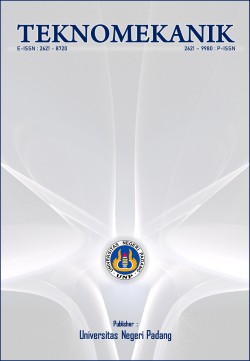Pemanfaatan Motor Listrik Bertenaga Energi Matahari Sebagai Penarik Jaring Pada Kapal Nelayan
DOI:
https://doi.org/10.24036/jptk.v2i3.5723Keywords:
solar cell, electric motor, fishing boat, fishing groupAbstract
This article aim to be able to take advantage of an electric motor as a net puller on a fishing boat using solar energy. The use of human labor as a net puller requires a large amount of energy and needs a break to be able to do more withdrawal activities, so the number of withdrawals that can be done is very limited. Pantai Jaya fishing groups as partners are among the 20 active fishing groups in the Pasie Nan Tigo sub-district of Koto Tangah subdistrict of Padang City who experience these problems. The problem of this partner can be given a solution in the form of the use of an electric motor as a towing net on a fishing boat. In order not to cause problems in terms of electricity supply, solar energy can be used by using solar cells, so there is no addition of fuel oil. The implementation method given is direct installation and provision of extension materials on the use of solar cell technology and the introduction of components and hand tools. This activity was carried out for two days which included preparation, installation and training, followed by a group of fishermen. The fishing group received a set of solar cells, electric motors, batteries and other accessories and installed them. Based on tests that have been carried out in sunny weather conditions at 300C, a load of 50 kg with a rated voltage at that time 12.4V, motor speed 2.7m / min, 2.4A. Based on the results of these tests indicate that the solar cell system has worked according to the parameters it should. Therefore, it can be said that this activity has been carried out properly and the solar cell system is functioning properly. Participants hope for these activities to be carried out for the following year, because there are still a number of fishing boat groups that are in dire need.
Downloads
References
[2] RUPTL, Rencana Usaha Penyedia Tenaga Listrik PT PLN (Persero) Tahun 2016 s.d. 2025. 2016.
[3] W. Yandi, Syafii, and A. B. Pulungan, “Tracker Tiga Posisi Panel Surya Untuk Peningkatan Konversi Energi Dengan Catu Daya Rendah,” J. Nas. Tek. Elektro, vol. 6, no. 3, pp. 159–167, 2017.
[4] Republik Indonesia, Rencana Strategis Kementrian Energi dan Sumber Daya Mineral (Renstra KESDM). 2015.
[5] H. J. Loschi, Y. Iano, and J. Leon, “A review on photovoltaic system: Mechanisms and Methods for Irradiation Tracking and Prediction,” Smart Grid Renew. Energy, vol. 6, pp. 187–208, 2015.
[6] S. Hagerman, P. Jaramillo, and M. G. Morgan, “Is rooftop solar PV at socket parity without subsidier,” Energy Policy, vol. 89, pp. 89–94, 2016.
[7] S. Yondri, R. A. Nabawi, Fibriyanti, Firmansyah, Herisajani, and S. Islami, “Utilization of Potential Water Energy in Irrigation Channels for PicoHydro Power Plant,” in International Conference of Applied Science on Engineering, Business, Linguistics and Information Technology, 2017.
[8] A. B. Pulungan, J. Sardi, Hastuti, S. Islami, and Hamdani, “Pemasangan Solar Cell untuk Kapal Nelayan,” J. Inf. Technol. Comput. Sci., vol. 2, no. 2, pp. 1–6, 2019.





